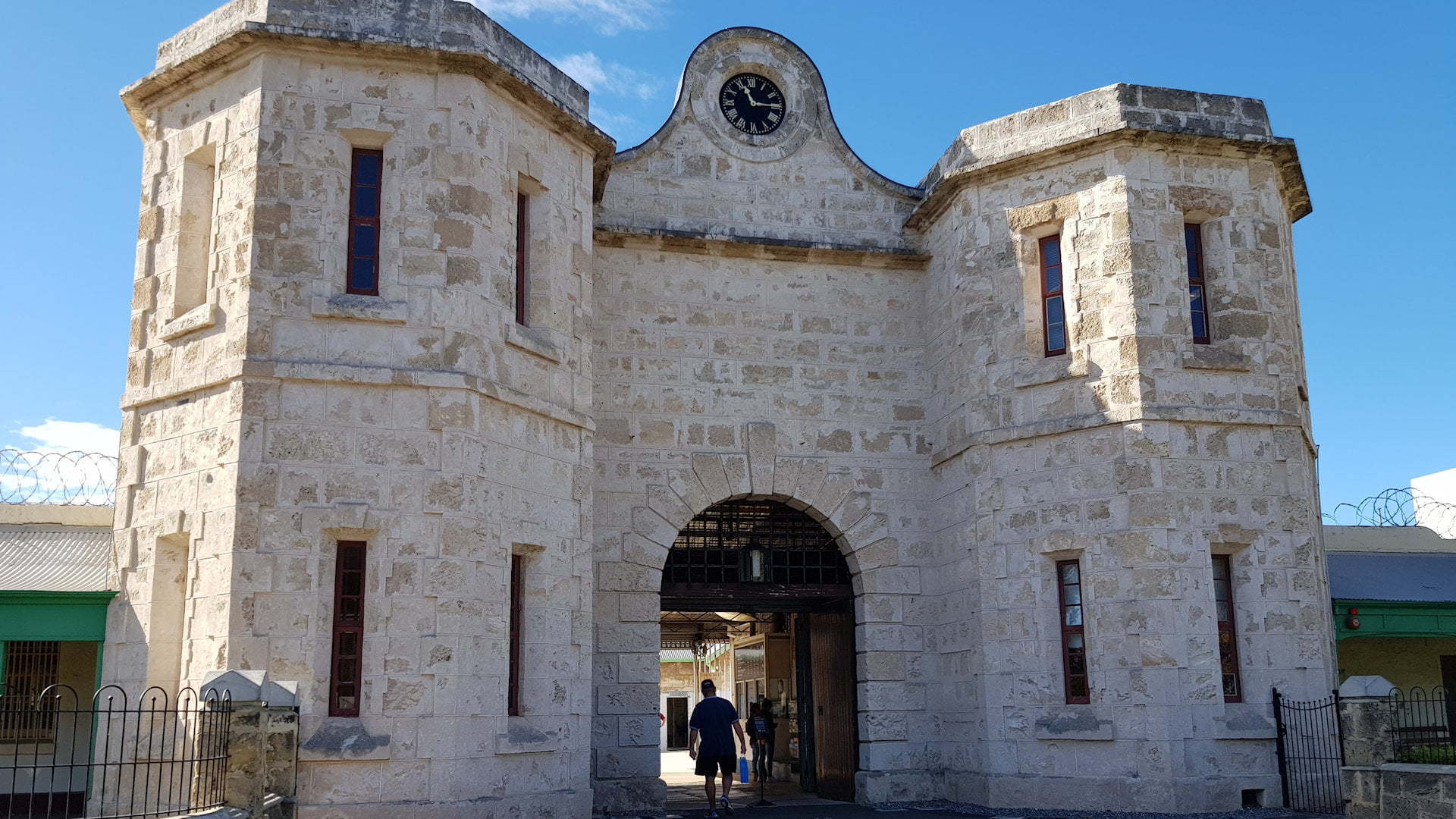
Fremantle Prison is an Australian convict era establishment, operating for around 140 years between 1852 and 1991.
It started as a convict prison, first called The Establishment before being renamed to Fremantle Prison in 1867. It took over from the Round House ![]() as being the primary prison for the Perth region.
as being the primary prison for the Perth region.
The archway to the entrance of the prison immediately gives a sense of when the prison was built, originally by the convicts sent to be imprisoned in it.
Fremantle Prison began confining only imperial convicts. It was built to hold 1,000 prisoners but by 1886 there were less than 60 when it was transferred to the colonial government. On the closing of Perth Gaol, Fremantle Prison became the main confinement place for the western colony of Australia.
The 1890 gold rush increased the population of the colony and Fremantle Prison became busy again. Needing more space, when Rottnest Island Aboriginal Prison closed in 1903, prisoners were sent for public works.
It served as a military detention centre during World War II, housing a number of Italian Australian’s identified as enemy aliens during the war.
It took a royal commission in 1983 to recommend closure in response to prisoner riots and concerns with the prison conditions. The Fremantle Prison was eventually closed in 1991.
Tours
There are several tours you can take at Fremantle Prison with different perspectives on prison life and how the prison operated in its heyday.
Tour packages combine multiple tours for better value and a broader experience of Fremantle Prison.
Convict Prison
Focuses on the history of Fremantle Prison, starting from when construction began in the 1850s, through to the end of the convict era in the 1880s. It tells about why men were transported from Great Britain and Ireland, and the convicts helped build their own prison.
Behind Bars
Find out what it was like to be behind the bars in a maximum security gaol from the 1880s through to 1991. This convict-built prison became the primary place of incarceration for men, women, and children in Western Australia. Learn about the realities of life on the inside, walk through the main cell block and exercise yards.
True Crime
Bushrangers, murderers, thieves, bank robbers, and serial killers. In 140 years of criminal history, there are many real-life stories of Fremantle Prison’s worst criminals. Because of the nature of the true stories, it is recommended children to be over 10 years of age.
Tunnels
Fremantle Prison has a labyrinth of tunnels built by prisoners. Get fitted with a trendy set of overalls and a hardhat and climb down 20 metres below the prison to discover blast holes, recesses, artefacts and more.
The tunnels tour is physically demanding so it is not for everyone. Children must be 12 years or older and accompanied by an adult. You must be physically fit, able to climb unassisted, not suffer from a fear of heights or claustrophobia. And if you think about having a drink or two to relax you before going, there is a mandatory breath test too. Weight needs to be between 40km and 140kg.
The tunnels tour is the most expensive tour at Fremantle Prison but you can add one of the other tours for $10 as a Tunnels and Prison package.
Torchlight
See Fremantle Prison in a different light, or at least less of it. Hear about the sordid stories in the dark. Stories of pain and suffering, executions that have gone wrong, and the innocent being imprisoned with the guilty.
Tour Packages
The Convict Prison, Behind Bars, and True Crimes can be combined into packages. The price of one tour increases by $10 per person for an additional tour, or by $20 to do all three tours.
The Tunnels Tour can have any one of these tours added to it, also for an extra $10 per person.
Australian Convict Sites World Heritage
Fremantle Prison is one of several Australian Convict Sites recognised for its World Heritage value. It was added to the World Heritage List in 2010, along with 10 other historic sites around Australia
The sites represent the global story of colonial expansion, mass migration of the unwilling labour force, and the punishment of crime in the modern era. The eleven penal sites are examples of Australia’s rich convict history, exemplary convict sites selected from more than 3,000 established by the British Empire on Australian soil in the 18th and 19th centuries.
- Norfolk Island
- Kingston and Arthur’s Value Historic Area – 1788 to 1814 and 1825 to 1856
- New South Wales
- Old Government House and Domain – 1819 to 1848
- Hyde Park Barracks – 1819 to 1848
- Old Great North Road – 1826 to 1836
- Tasmania
- Brickendon-Woolmers Estates – 1820 to 1850s
- Darlington Probation Station – 1825 to 1832 and 1842 to 1850
- Cascades Female Factory – 1828 to 1877
- Port Arthur Historic Site – 1839 to 1877
- Coal Mines Historic Site – 1833 to 1848
Fremantle Prison is the only Australian convict site added to the World Heritage List in 2010.
To get there:

From


